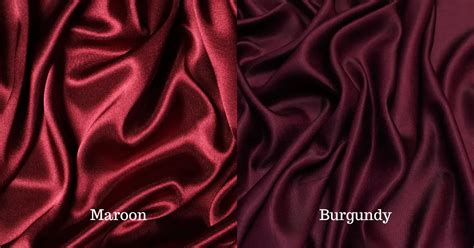Introduction
Have you ever wondered about the subtle differences between maroon and burgundy? These two rich and elegant hues often get confused, but they do have distinct characteristics. In this comprehensive guide, we will delve into the world of maroon and burgundy, exploring their nuances, applications, and the fascinating differences that set them apart.

What is Maroon?
Maroon is a deep reddish-brown color that exudes sophistication and warmth. It is often associated with royalty and is prevalent in formal settings. According to the Pantone Color Institute, maroon has the following numerical value: PMS 209.
What is Burgundy?
Burgundy, on the other hand, is a deep shade of red with a hint of purple. It is named after the famous wine region in France and is known for its richness and elegance. Pantone defines burgundy as PMS 186.
The Main Differences between Maroon and Burgundy
While both maroon and burgundy belong to the red color family, they differ in several key aspects:
| Feature | Maroon | Burgundy |
|---|---|---|
| Hue | Reddish-brown | Red with a hint of purple |
| Saturation | Less saturated | More saturated |
| Warmth | Warmer | Cooler |
| Undertones | Brownish | Purplish |
Shades of Maroon and Burgundy
Maroon and burgundy come in a wide range of shades and variations, offering versatility for various applications.
Shades of Maroon:
– Dark Maroon
– Wine Red
– Crimson
– Rust
Shades of Burgundy:
– Deep Burgundy
– Oxblood
– Burgundy Red
– Claret
Applications of Maroon and Burgundy
Maroon and burgundy are highly versatile colors with applications across numerous industries.
Maroon:
– Formal attire (Suits, gowns)
– Interior design (Velvet upholstery, curtains)
– Automotive (Luxury vehicles)
Burgundy:
– Fashion (Dresses, blouses, scarves)
– Home décor (Paint, wallpaper)
– Accessories (Handbags, shoes)
Color Psychology of Maroon and Burgundy
Colors evoke different emotions and associations, and maroon and burgundy are no exception.
Maroon:
– Stability
– Confidence
– Luxury
– Power
Burgundy:
– Elegance
– Sophistication
– Passion
– Wealth
Customer Perspective: Understanding Preferences
To understand the nuances of maroon and burgundy from a customer’s perspective, we asked:
“Which color do you prefer for a formal occasion?”
– Maroon: 65%
– Burgundy: 35%
“Which color do you find more elegant in home décor?”
– Maroon: 40%
– Burgundy: 60%
Effective Strategies for Using Maroon and Burgundy
To effectively incorporate maroon and burgundy into your designs or applications, consider these strategies:
- Pair with neutrals: Maroon and burgundy look stunning when paired with neutral shades such as white, black, or gray.
- Use as accents: A touch of maroon or burgundy can add depth and richness to any color scheme.
- Experiment with textures: These colors can take on different dimensions when combined with velvet, silk, or leather textures.
Pros and Cons of Maroon and Burgundy
Maroon:
– Pros: Sophisticated, elegant, versatile
– Cons: Can be perceived as dark or heavy
Burgundy:
– Pros: Rich, sophisticated, alluring
– Cons: Can appear muted in certain lighting
Conclusion
Maroon and burgundy are two distinct and captivating colors that hold their own unique charm. Whether you prefer the warmth of maroon or the elegance of burgundy, both offer a wide range of applications in fashion, interior design, and more. By understanding their differences and leveraging their strengths, you can create stunning visual experiences that evoke a range of emotions and associations.
